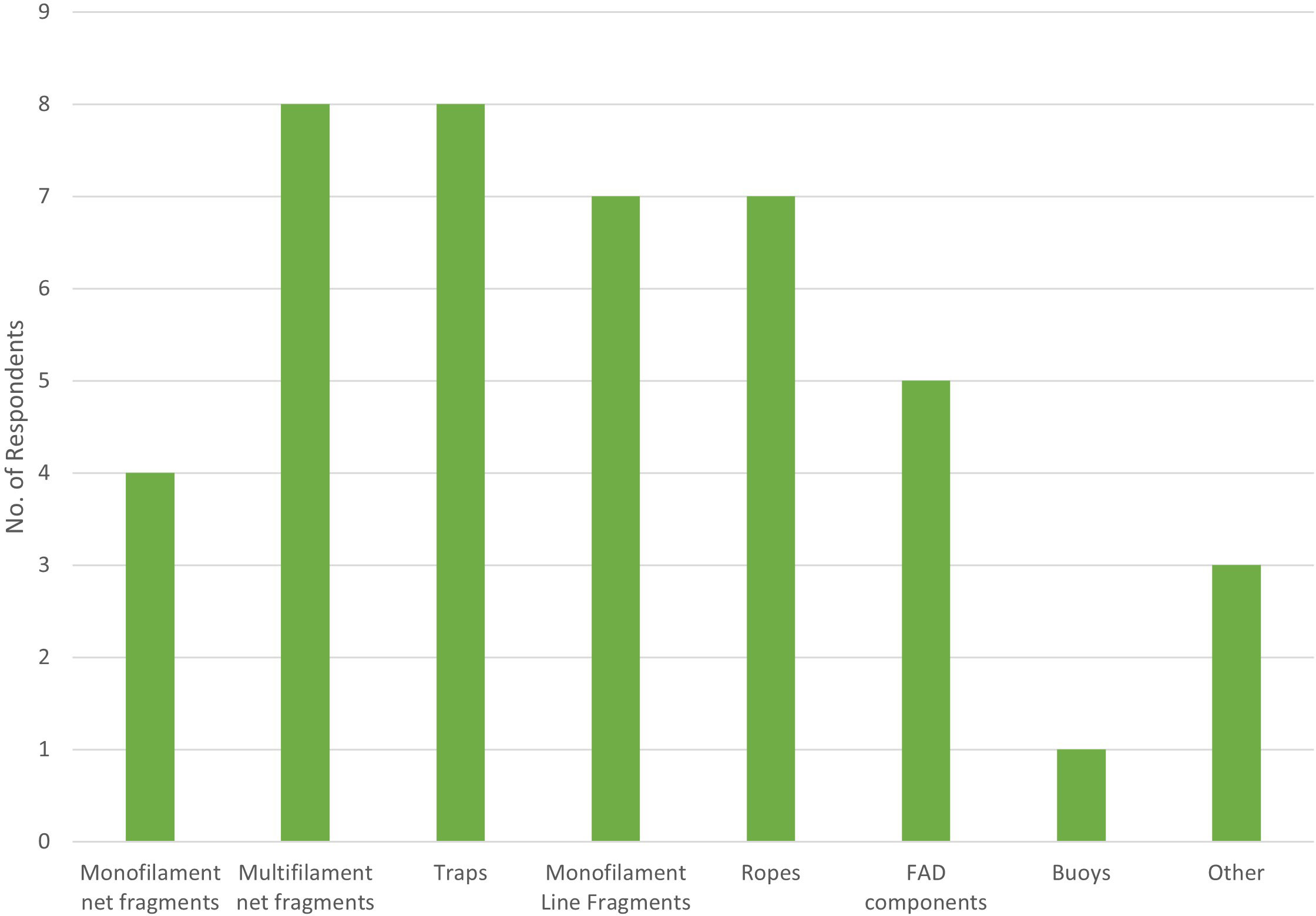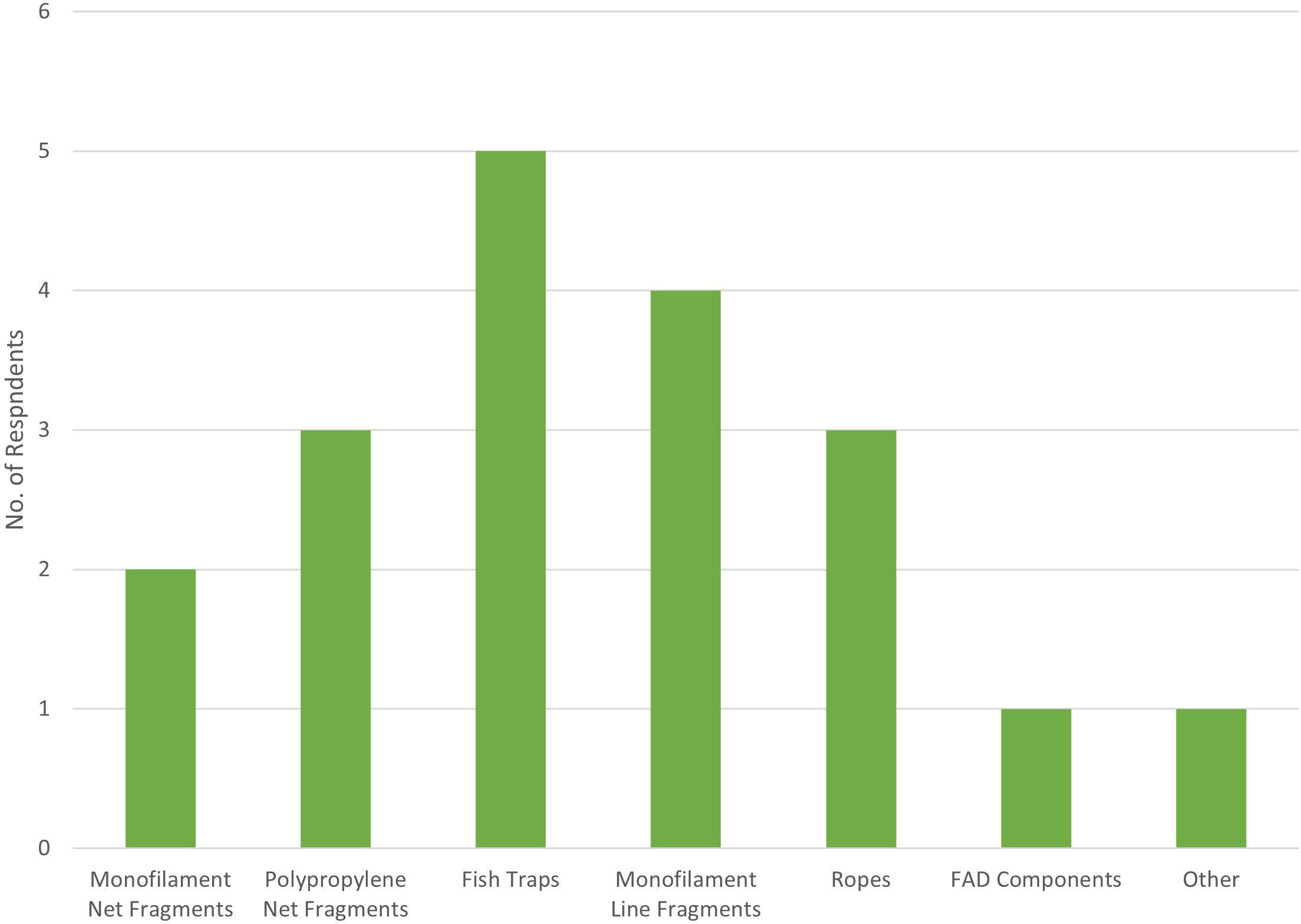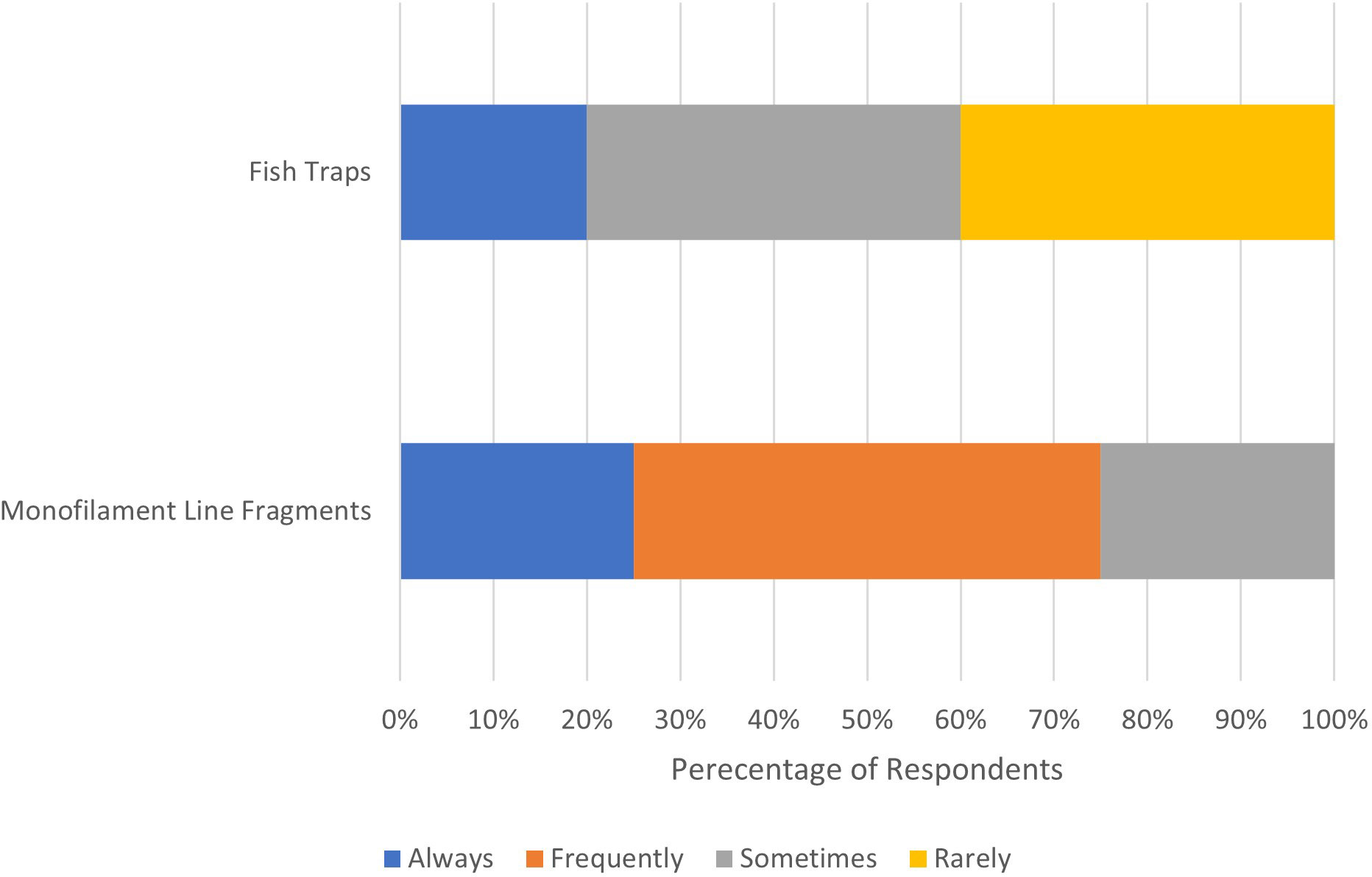- 1World Maritime University (WMU) - Sasakawa Global Ocean Institute, World Maritime University, Malmö, Sweden
- 2Fisheries Division, Ministry of Foreign Affairs, Agriculture, Trade and Barbuda Affairs, St. John, Antigua and Barbuda
Abandoned, lost and otherwise discarded fishing gear (ALDFG) presents a significant and complex challenge which can result in severe deleterious impacts to habitats, marine wildlife, and fishing and coastal communities the world over. Small island states like the countries of the Eastern Caribbean are highly vulnerable to a range of external stressors, therefore it is essential to gain an understanding of the threat posed by all forms of marine debris including ALDFG to the sub-region. To gain an understanding of the drivers, scale and impact of the threat associated with small-scale fisheries of the Eastern Caribbean, interviews with 49 fish trap and line fishers as well as 14 divers in Antigua and Barbuda, and Dominica were conducted. Interviews were completed over the course of two months (July – August 2022) at landing sites around all three islands. Fish traps continue to be a major contributor to ALDFG in the study area, with an estimated 2, 273 traps and 2, 567 being lost on Antigua and Barbuda, and Dominica respectively, based on the most recent estimates of the fishing fleet. Severe weather and snagging of benthic obstructions have emerged as the most significant contributors to fish trap loss in both countries while towing of fishing lines was the most frequently identified cause in the countries’ line fisheries. Observed variabilities in drivers of loss between both countries may be attributed to a number of factors including diversities in the fishing sectors, differences in local practices and heterogeneity in the biogeography of the marine environment. Further, evidence shows that the challenge of ALDFG within the Eastern Caribbean context, goes beyond local drivers of loss and may be influenced by transboundary inputs from both within and outside the region. Divers reported encountering not only ALDFG originating from within the two countries but some forms of ALDFG that may have drifted into the area from neighbouring islands (MFAD components) or further afield (polypropylene netting). Managing this challenge effectively will require not only fisheries specific interventions but the cooperation and collaboration of pool of stakeholders both nationally and beyond.
1 Introduction
Abandoned, lost and otherwise discarded fishing gear (ALDFG), also referred to as derelict fishing gear, is a complex global problem for which there remains large knowledge gaps and regional disparities in our understanding of its scope and scale (Richardson et al., 2019; GESAMP, 2021; Richardson et al., 2021b; Do and Armstrong, 2023). Despite these knowledge gaps, it has been well established that ALDFG is of growing concern to the sustainability of global fisheries (Richardson et al., 2019) and is a major component of floating plastic debris found in some regions (Lebreton et al., 2022). It is also widely considered to be perhaps the most dangerous form of marine debris since it is designed to entrap, ensnare or capture marine organisms and can do so long after it becomes derelict (Norris et al., 2011; NOAA Marine Debris Program, 2015; Wilcox et al., 2015; Nama and Prusty, 2021). ALDFG threatens wildlife and benthic habitats, can result in navigational hazards, and may lead to negative socioeconomic impacts to fishers (Laist, 1997; Asoh et al., 2004; Hong et al., 2013; NOAA Marine Debris Program, 2015; Stelfox et al., 2016; Hong et al., 2017). Derelict traps on the ocean floor may shift leading to scouring of the substrate and damage to marine organisms including stony corals, sponges and gorgonians (Stevens, 2021). Other impacts associated with ALDFG may include the transfer and distribution of microplastics into the food web, distribution of harmful algal blooms and the transfer of invasive alien species (Gilman et al., 2022).
The islands of the Eastern Caribbean are highly dependent on tourism, which is among the highest income earner in countries like Antigua and Barbuda, and St. Kitts and Nevis (UNDP, 2022). Much of this tourism is nature based and marine oriented, thus there is a strong economic imperative to address those issues that negatively impact the marine environment including all forms of marine pollution. With their dependence on tourism, high product importations and poor waste management systems, Caribbean islands generate more waste per capita than the global average (Clayton et al., 2021). Further, while it is widely acknowledged that land-based sources constitute the major contributor of marine litter globally, including in the Caribbean (UNEP-CEP, 2014; Diez et al., 2019), the sources of marine debris in the region can be attributed not only to poor waste management practices and land-based activities such as coastal tourism but also to nearshore maritime activities including fishing (Kanhai et al., 2022). The issue of marine debris in the Caribbean has also been shown to be a transboundary challenge, with evidence suggesting that plastic waste originating from both within and outside the region is transported and distributed through sea surface currents (Kanhai et al., 2022). In a recent study it was found that micro-plastic waste found in the coastal waters of Antigua were likely transported to the area from the North Atlantic Ocean (Courtene-Jones et al., 2021). That study also found that, of the countries assessed, Antigua was the only one where plastic rope featured among the most significant sources of marine litter material (Courtene-Jones et al., 2021).
The drivers of fishing gear loss are varied and dependent on a number of local and global factors, including “operational and environmental variables, and gear characteristics” (Richardson et al., 2022). A recent study has suggested that on average 0.81% of gillnets, 3.33% of longline mainlines and 0.74% of all traps or pots are lost, globally each year (Richardson et al., 2022). However, that study also noted that major knowledge gaps remain on the losses experienced by artisanal and recreational fisheries (Richardson et al., 2022). In a previous global assessment of ALDFG drivers it was further found that weather was one of the most commonly identified causes of fishing gear loss among seven countries across all regions of the globe (Richardson et al., 2021a). This was followed by wildlife interactions and snagging of benthic obstructions by gear that interacts with the seafloor (Richardson et al., 2021a). Understanding fisheries specific drivers as well as their relative importance and magnitude is critical to identifying priorities for intervention (Gilman et al., 2022).
In the small islands of the Eastern Caribbean few academic articles have focused on understanding the scale and impact of ALDFG or identifying drivers of loss. A review of the grey literature, however, provides evidence that ALDFG is of growing concern to regional fisheries authorities and is occurring within small-scale fisheries in the Caribbean region. Further, one assessment on the opinions of ALDFG in the Caribbean found that marine debris and ALDFG were regarded as areas of concern among the majority of persons interviewed (85% and 65% of respondents respectively) (Matthews, 2010). Fish traps were considered to be most common form of ALDFG followed by a range of different nets, and various forms of hook and line gear (Matthews, 2010). Interview participants also reported that as much as 60.1% of ALDFG was located underwater with the remaining components likely to be found floating or deposited on shorelines (Matthews, 2010). Interviews of fisheries officials in the Wider Caribbean ahead of FAO’s 2019 regional workshop on best practices to reduce and prevent ALDFG also revealed that more than half of the respondents viewed ALDFG as high or major concern for the Caribbean region (FAO, 2020). Among the challenges identified by interviewees for its management were the lack of reporting, lack of awareness among fishers and the inability to retrieve lost gear (FAO, 2020).
Post cyclone damage assessments and other research conducted by some Eastern Caribbean countries and territories provide strong evidence that severe weather (both storms and hurricanes) potentially serve as a major contributary factor of fishing gear loss in the region, particularly within fish trap fisheries. Damage assessments conducted in Antigua and Barbuda, and Dominica in the wake of tropical cyclones that affected the Eastern Caribbean from the late 1990s to as recently as 2017 resulted in an estimated loss of 19, 781 traps across the two small island developing states that form part of this review (Horsford, 2010; Norris et al., 2011; Horsford, 2017). Each of these traps could continue to capture marine organisms (ghost fish) for up to a year (Norris et al., 2011), and perhaps longer in the case of traps braced with steel instead of wood.
The fisheries of the Eastern Caribbean small-island states can largely be categorized as small-scale or artisanal in nature. They are generally multi-gear, multi-species fisheries and utilize a variety of gear (i.e., hand line, long line, beach or boat seines, gillnets and traps) for the harvesting of a range of different pelagic, demersal and benthic/sedentary resources (CRFM, 2021). Fish traps used in East Caribbean fisheries and which, according to previous reports, are among the most concerning forms of ALDFG (Matthews, 2010), are mainly constructed from either welded steel or wooden frames, which are covered by a wire mesh. Traps may be constructed in a variety of shapes (rectangular, Z/S shaped or a chevron/arrow-head pattern) with one or more funnels through which fish and other marine organisms enter and may also include an escape hatch/door.
In addition to these main gear types, a number of Eastern Caribbean states have in recent years been steadily introducing moored fish aggregating devices (MFADs) into their national fisheries. A recent study of the region’s MFAD fishing sector estimated that there was a total of 110 MFADs deployed in the Eastern Caribbean states of Antigua and Barbuda, Dominica, Grenada, Montserrat, St. Kitts and Nevis, St. Lucia, St. Vincent and the Grenadines, and The British Virgin Islands (Wilson et al., 2020). In many states, the vast majority of these were privately owned either by an individual or a small group of fishers (Wilson et al., 2020). MFADs can provide important social and ecological benefits to small-scale fisheries in the Eastern Caribbean (Wilson et al., 2020); however, if poorly managed, they also have the potential to contribute to marine pollution since MFADs will eventually degrade and become lost at sea (Sinopoli et al., 2020). This is even more concerning given the large number of privately owned MFADs in the region as these are quite often cheaply constructed with high turnover rates (Wilson et al., 2020). A recent evaluation of the regulatory strength of MFAD management within the Caribbean found that only Antigua and Barbuda, and St. Vincent and the Grenadines had relatively high regulatory strengths when assessing their management regimes against a three-component governance framework (regulation of MFAD deployment, regulation of access to MFADs, and regulation of fishing practices on MFADs) (Wilson et al., 2022). The regulatory strength scores were based on a range of 0 to 1, with both countries achieving the maximum score of 1 (Wilson et al., 2022). By contrast, all other Eastern Caribbean states scored less than 0.5 (Wilson et al., 2022).
The following study sought to understand the drivers, scale and impact of ALDFG within the context of Eastern Caribbean small-scale fisheries. To do so fishers in two Eastern Caribbean Island states Antigua and Barbuda, and Dominica were interviewed. The archipelagic state of Antigua and Barbuda has an estimated shelf area of 3 886 square km (Pauly et al., 2020). This includes the Antigua and Barbuda shelf, South Bank, a section of the Anguilla shelf, Redonda shelf, Havers Shoal and a section of the St. Kitts and Nevis Shelf (Singh-Renton and McIvor, 2015). By contrast, Dominica’s shelf is significantly smaller, measuring just 356 square km (Pauly et al., 2020). These differences in their bathymetry have likely impacted the characteristics of the countries’ fisheries sectors. For instance, Antigua’s benthic habitat is dominated by coral frameworks on the Eastern and Southern shelves and coastal embayments around the island “are heavily colonized by seagrass” (The Nature Conservancy, 2016). The Antigua and Barbuda shelf from which the main islands emerge is one of the largest in the Eastern Caribbean and supports a substantial demersal fishery (Singh-Renton and McIvor, 2015) On the other hand, Dominica’s narrow coastal shelf has “a paucity of coral frameworks” (The Nature Conservancy, 2016) while pelagic species make up the majority of the country’s landings (FAO, 2022). These two countries were chosen since the author considers that they offer contrasting representations of the Eastern Caribbean’s diverse artisanal fleet (one sector being largely dominated by a demersal fleet, with the other dominated by a pelagic fleet).
2 Methodology
2.1 Gear loss questionnaires
To complete this research, gear loss questionnaires from the FAO Global Assessment of ALDFG were administered to line and trap fishers on the islands of Antigua, Barbuda, and Dominica. Face-to-face interviews were conducted over the course of two months (July to August 2022) at various landing sites. Because interviewees were randomly and opportunistically targeted only primary landing sites were visited over the data collection period. Due to the multi-gear nature of the fisheries, fishers who engaged in more than one type of fishing activity were asked to respond to more than one gear questionnaire.
A total of 49 gear fishers were interviewed across both countries (23 in Antigua and Barbuda and 26 in Dominica). Of these 36 were trap fishers and 28 were line fishers, with several participants operating more than one gear type. Participants ranged in age from 28 years to more than 70 years old. Many indicated that they had been fishing since childhood, while more than 75% had over 20 years fishing experience. Only one fisher indicated he had been fishing for one year, while all others had been fishing for at least five years or more. While a complete set of interview questions was asked of each participant only those questions that would provide insight into drivers, of gear loss as well as scale and impact of ALDFG have been analysed for this research. Responses to the examined questions were loaded unto an Excel spread sheet and analysed. The parameters analysed through fisher interviews were: (1) Main causes of fishing gear loss for both line and trap fishers, (2) Frequency of loss for component gear parts for both line and trap fishers, and (3) Rates of Trap Loss (Supplementary Data sheet 1).
2.2 Diver interviews
To gain a clearer understanding of the scale of the ALDFG challenge within the two countries being assessed and to augment the gear specific data derived from the FAO Global Assessment questionnaires, diver interviews provided an opportunity to assess the underwater environment and ALDFG encounter rates. For these diver interviews, semi-structure interview questions were used in order to assess to what extent divers encountered ALDFG during diving operations, the frequency of such encounters and the most abundant forms of derelict gear frequently encountered (Supplementary Data Sheet 2). Divers were also asked to comment on some of the observed impacts associated with the derelict fishing gear. To gain a variety of diver perspectives the researcher targeted not only commercial SCUBA diving spear fishers and/or conch divers but also recreational divers and divers who engage in conservation work. A total of 14 divers were interviewed across the two countries (9 were spear fishers/conch divers, 2 were recreational divers and 3 were conservation workers).
2.3 Data limitations
The quality of the data collected through interviews may be influenced by a number of factors including the ability of fishers to comprehend the questions being posed and the avoidance of bias by the interviewer while posing questions. Because questionnaires were administered in the field, often while fishers were working (e.g., repairing gear), the possibility exists that inaccuracies may have been introduced as a result of fishers not being completely engaged. The results from these interviews may be extrapolated across the study area, however, it must be acknowledged that this is limited by the availability of current data on the population size of the fisheries being studied.
The inclusion of diver interviews provided an opportunity to gain an understanding regarding submerged forms of ALDFG that exist within the study area. It is acknowledged that the sample size for divers interviewed is relatively small, particularly in the case of Dominica, but the information that they have provided remains valuable. It is also acknowledged that ALDFG encounter rates by divers may be influenced by a number of external factors including the depths they dive and proximity to fishing grounds. The inclusion of spare fishers as well as recreational diver could help compensate for these influences, but ultimately the results could have been improved with a larger sample size.
3 Results
3.1 Understanding the drivers of ALFDG and drivers of gear loss in the Eastern Caribbean
A number of similarities were observed with regard to the identified drivers of trap and line loss in both Antigua and Barbuda, and Dominica. In both Antigua and Barbuda, and Dominica severe weather and snagging on benthic obstructions were among the most frequently cited causes of fish trap loss (Supplementary Figure 1). Drifting out of range appeared to be a greater concern in Dominica while vandalism, and conflict with other gear were more often cited in Antigua and Barbuda. Towing of line gear by large animals (mainly pelagic fish) was the most significant cause of line loss in both jurisdictions (Supplementary Figure 2). A detailed analysis of these results is presented in the following sections.
3.1.1 Antigua and Barbuda
Among the trap fishers who were interviewed in Antigua and Barbuda, the most frequently identified causes of gear loss were severe weather (92.9% of respondents), vandalism (85.7% of respondents), and snagging on reefs, rocks or other obstructions (78.6% of respondents) (Figure 1). Strong currents and operator error were also found to be major causes of fish trap loss in Antigua and Barbuda, as indicated by 78.6% of respondents. Few individuals (~ 30%) identified the loss or malfunctioning of surface markers as a major cause of trap loss with most fishers indicating that this was not relevant to their operation. Contrastingly, conflict with other gears was reported by more than 50% of interviewees. Neither of these results are surprising since trap fishers in Antigua and Barbuda typically set their traps “blind” in an effort to avoid theft. In blind setting, two traps are tied together without a surface marker attached and their location marked with a GPS. In order to haul the traps, fishers use a grapnel (“creeper”) to catch and retrieve the connecting rope. Approximately 38% of trap fishers indicated that they intentionally discarded traps at sea once they reached their end of life. However, this practice was primarily indicated by those fishers who used wood to brace/form the frame of their traps. In those instances, the fishers indicated that they removed the rope and any other plastic component from the traps, crushed the funnel to prevent fish from entering, and discarded the wire at sea. The ropes and buoys/other plastic components were returned to land and reused or discarded onshore. Fishers who used steel-frame traps generally brought them back to shore once the wire mesh had reached its end of life. The corroded wire mesh was then removed from the steel frame which was repaired/rewelded and used to reconstruct the traps with a new mesh, while the old mesh was discarded in the garbage. This practice notwithstanding, one individual indicated that he routinely removed the wire from the steel frame and discarded the mesh at sea while returning the frame to land for reuse. Only three fishers indicated other causes of loss that were not included among those listed, these were Sargassum, ropes bursting during trap retrieval and ropes falling off the creeper during retrieval.
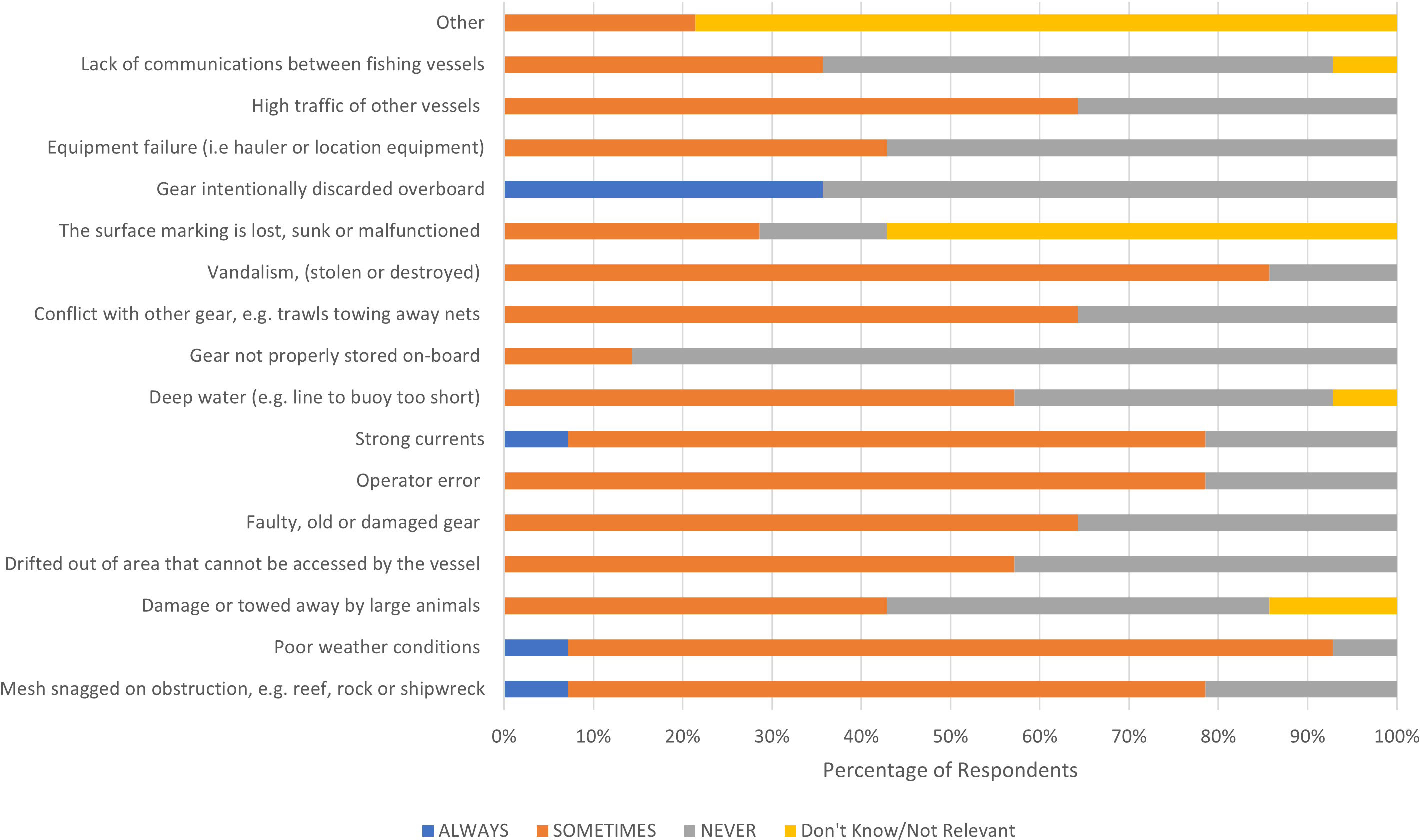
Figure 1 Summary of survey results from Antigua and Barbuda to the question: “When a vessel loses traps, what are the main causes of the gear loss and their corresponding frequency of occurrence?” (n = 14).
The most frequently cited causes for line loss among Antigua and Barbuda fishers were damage/towing by large animals (89%), strong currents (78%), poor weather (67%) and snagging (56%) (Figure 2). The snagging of fishing line was generally regarded to occur most often in shallow areas. However, pelagic fishers, who fished around MFADs indicated that lines could also snag on the FAD itself. Only one individual indicated that they had lost fishing line due to improper storage on board the vessel. Fishers generally have dedicated containers on board for the storage of lines on the way to the fishing ground. Deepwater was also not a major driver of loss for line fishers.

Figure 2 Summary of interview results from Antigua and Barbuda to the question: “When a vessel loses hooks or lines, what are the main causes of the gear loss and corresponding frequency of occurrence?” (n = 9).
With over half of respondents attributing the loss of traps and line to faulty or damaged gear, it raises concerns about the gear management routine across both fisheries. Trap ropes that are not maintained may snap during deployment or retrieval. Similarly, fishing lines may be weakened as a result of rodents or other vermin chewing on lines that have not been properly cleaned or stored following a fishing trip.
3.1.2 Dominica
In Dominica, the major causes of trap loss reported by interviewees presented some similarities with the Antigua and Barbuda results (Figure 3). For instance, severe weather emerged as the most commonly cited cause of fish trap loss in Dominica as well as in Antigua and Barbuda. In the case of Dominica, just over 90% of respondents indicated that this occurred either always or sometimes. Further, while, encounters with vessel traffic was sometimes revealed to be a major cause of trap loss in both countries by more than half of the interviewees, it is interesting to note that in Dominica just under 24% of respondents indicated this always occurred. This is perhaps not surprising given that while many fishers in Antigua and Barbuda set traps underwater the vast majority of Dominican fishers who were interviewed indicated that traps were set with surface markings. Further in many instances these fishers admitted to using plastic water or Clorox bottles instead of buoys to mark the location of their traps. Markers made from plastic bottles may be more difficult to see by oncoming vessels, are more likely to sink if they become filled with water or may be more easily cut away because they are not as durable as purpose-built marker buoys. Other major causes of trap loss in Dominica, as reported by more than half of the respondents, were traps drifting out of range, strong currents, and deep water. Equipment failure was not a major identified cause of trap loss, although all but one fisher indicated that they deployed and hauled traps by hand and generally used land marks to locate traps. While the intentional discard of fish traps by fishers was largely not reported, approximately 32% of respondents admitted to discarding the metal fish traps at sea once they are no longer usable (Figure 3). Almost all of the fishers interviewed indicated that their traps were built from wire mesh and braced with wood. One fisher indicated that he uses bamboo traps while another indicated he constructs his traps with a steel frame.
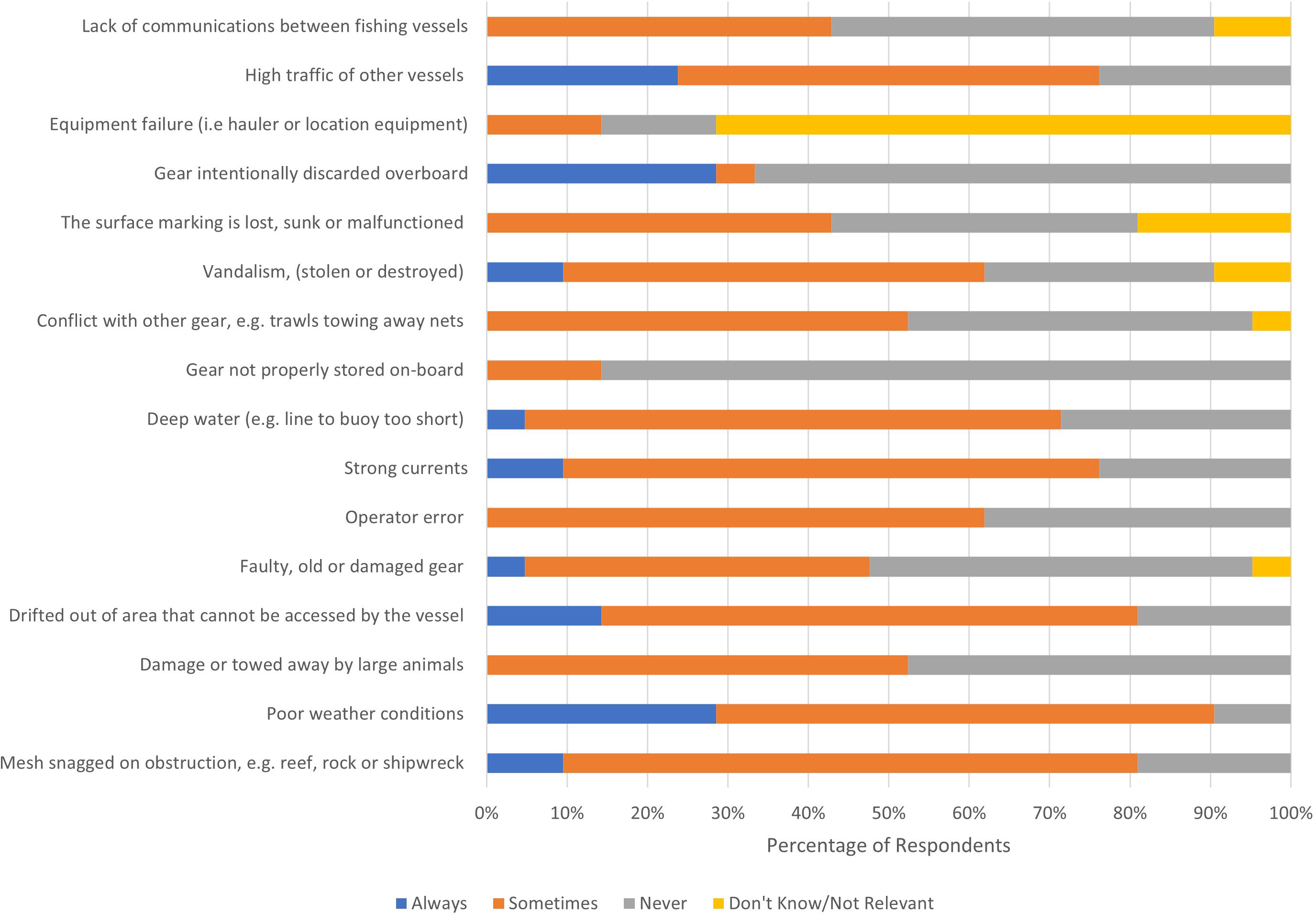
Figure 3 Summary of survey results from Dominica to the question: “When a vessel loses traps, what are the main causes of the gear loss and their corresponding frequency of occurrence?” (n = 21).
Both snagging and towing by large animals have emerged as a major contributing factor to the loss of fishing lines in Dominica (Figure 4), with approximately 74% and 84% of respondents respectively indicating that these sometimes led to line loss. Given that many of the interviewed fishers were targeting large pelagics such as tuna and marlin it is unsurprising that towing by large animals has been identified as a major cause of line loss. Fishers noted that large tunas often broke the lines or in some instances towed the “line traps” that fishers carry to the MFAD. These line traps are constructed of 2 or 3 small buoys attached to the vertical line and hook. Weather was not a major identified cause of line loss, with only approximately 74% of respondents indicating this never occurred.

Figure 4 Summary of interview results from Dominica to the question: “When a vessel loses hooks or lines, what are the main causes of the gear loss and corresponding frequency of occurrence?” (n = 18).
Faulty gear was identified as a contributor of both trap and line loss by 47.6% and 66.l7% of trap and line fishers respectively.
3.2 Understanding the Scale of ALDFG in the Eastern Caribbean
In order to gain insight on the scale of the ALDFG challenge in Antigua and Barbuda, and Dominica, fishers were asked to comment on the frequency with which they lost various components of both trap and line gears. This data was supplemented by information provided by divers who were asked to comment on their encounters with derelict fishing gear while diving. Combined results of diver interviews indicate that fish traps, line fragments, polypropylene netting and ropes are the most frequently encountered forms of submerged ALDFG (Supplementary Figure 3), with more than 80% of divers indicating they observe traps either always, frequently or sometimes (Supplementary Figure 4), more than 90% of divers observing polypropylene netting either frequently or sometimes (Supplementary Figure 5), more than 80% of divers encountering line fragments either always, frequently or sometimes (Supplementary Figure 6) and 70% of divers encountering ropes either frequently or sometimes (Supplementary Figure 7).
3.2.1 Antigua and Barbuda
Fishers were asked to indicate how often they lost either an entire set (all traps that were set), one unit (a single trap or traps that may be linked to form a single unit), or the surface buoys used in marking of traps. Of the fishers interviewed more than 50% indicated that they rarely or never lost an entire set of traps at once (Figure 5). Those who reported on the loss of an entire set, largely attributed such losses to severe weather, mainly hurricanes and storms. Because many of the fishers set traps underwater, without surface markers, many indicated that the loss of marker buoys was not applicable to their operations. All fishers who were interviewed indicated they had at least lost a single trap or a single unit of traps, with 30% indicating this occurred frequently, 53% indicating it occurred sometimes and 15% noting this rarely occurred.
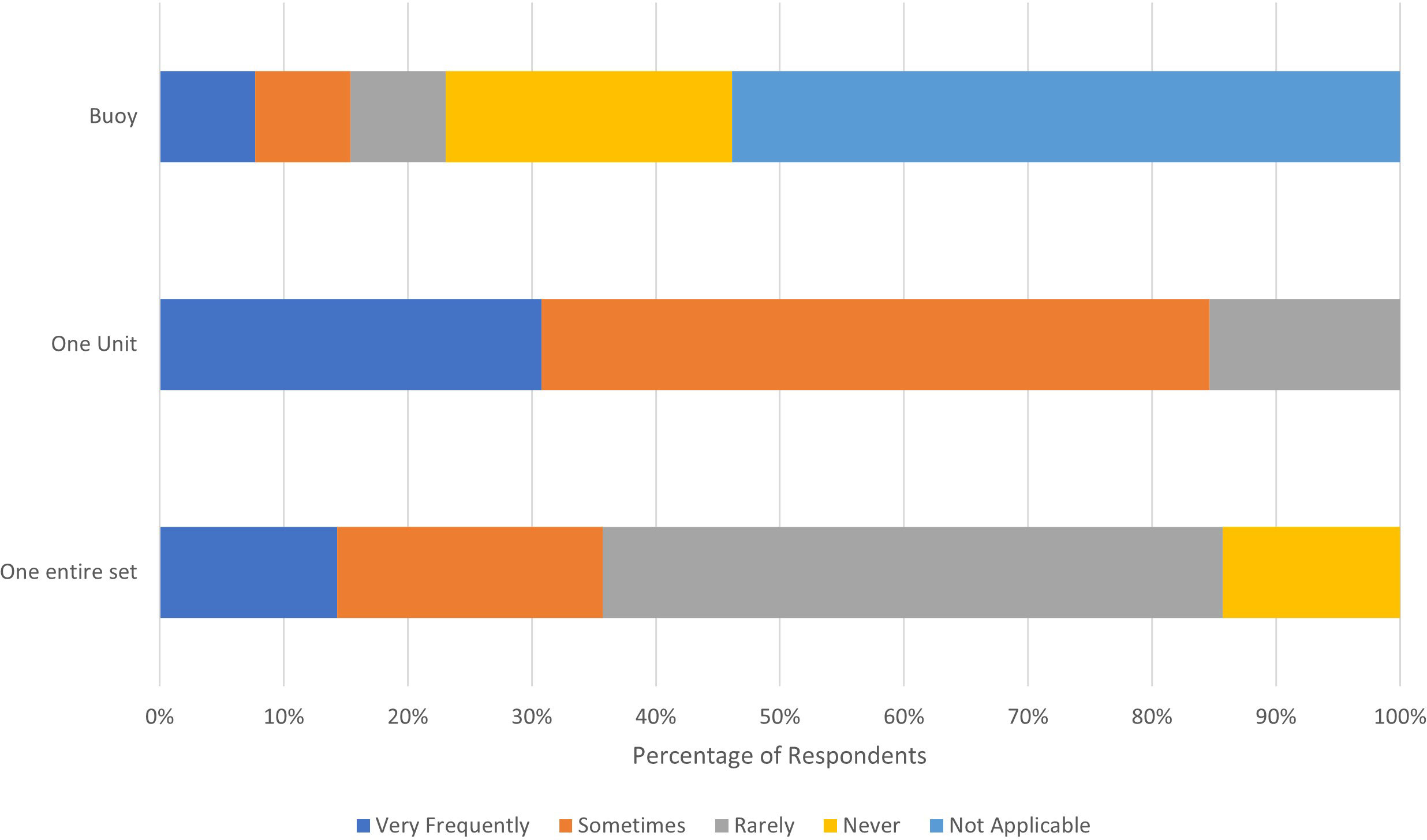
Figure 5 Summary of interview results from Antigua and Barbuda to the question: “When or if fish traps or parts of traps are lost which of the following elements are lost and in what frequency?” (n = 14).
In addition to commenting on the gear components that were lost and the frequency with which they were lost, trap fishers were also asked to estimate the number of traps lost in a typical year. Responses ranged from 2 to 60 traps at an average rate of 19.6 traps per fisher, per year. The fishers interviewed indicated that they fished between 18 and 160 traps per trip, at an average of 66.3 traps per fisher per trip. Based on the most recently available census data for Antigua and Barbuda (2021) there are 116 active fishing vessels with traps as the primary or secondary gear. Using an approach by Horsford (2017), it is estimated that these vessels would have deployed an average of 6, 684 trap units during fishing trips (Supplementary Data Sheet 3). Using the average loss rate of 19.6 traps per vessel, extrapolated against the total of 116 vessels it is estimated that fishers lose an average of 2, 273 traps per year, or about 34% of the estimated total of traps actively fishing. Undeniably the rate of fishing gear loss is likely to be affected by a number of external factors including the size of the fishing operation, fishing depths, the presence or absence of surface markers, and overcrowding on fishing grounds. Some fishers indicated that traps set in shallower waters were more likely to be affected by rolling currents. Further, as previously noted fishers who set their traps underwater in overcrowded fishing grounds were often impacted by gear conflicts as traps may become entangled if they are set on or near other traps.
Line fishers were asked to indicate how often they lost an entire set of lines (all lines actively fishing), a single unit of line, attached buoys only, attached floats only or plastic lures (artificial bait). Very few fishers indicated that they frequently or sometimes lost an entire set of lines, with more than 70% of those interviewed indicating that this either never occurred, was a rare occurrence or was not applicable to their operation (Figure 6). The one individual who explained that this was not applicable to their operation noted that he only fished a single hand line at a time. More than half of the fishers indicated that they had never lost a single unit of line, while that same ratio noted that they had lost buoys either sometimes or rarely. Almost 80% of the fishers interviewed indicated that they lost plastic lures either very frequently or sometimes.
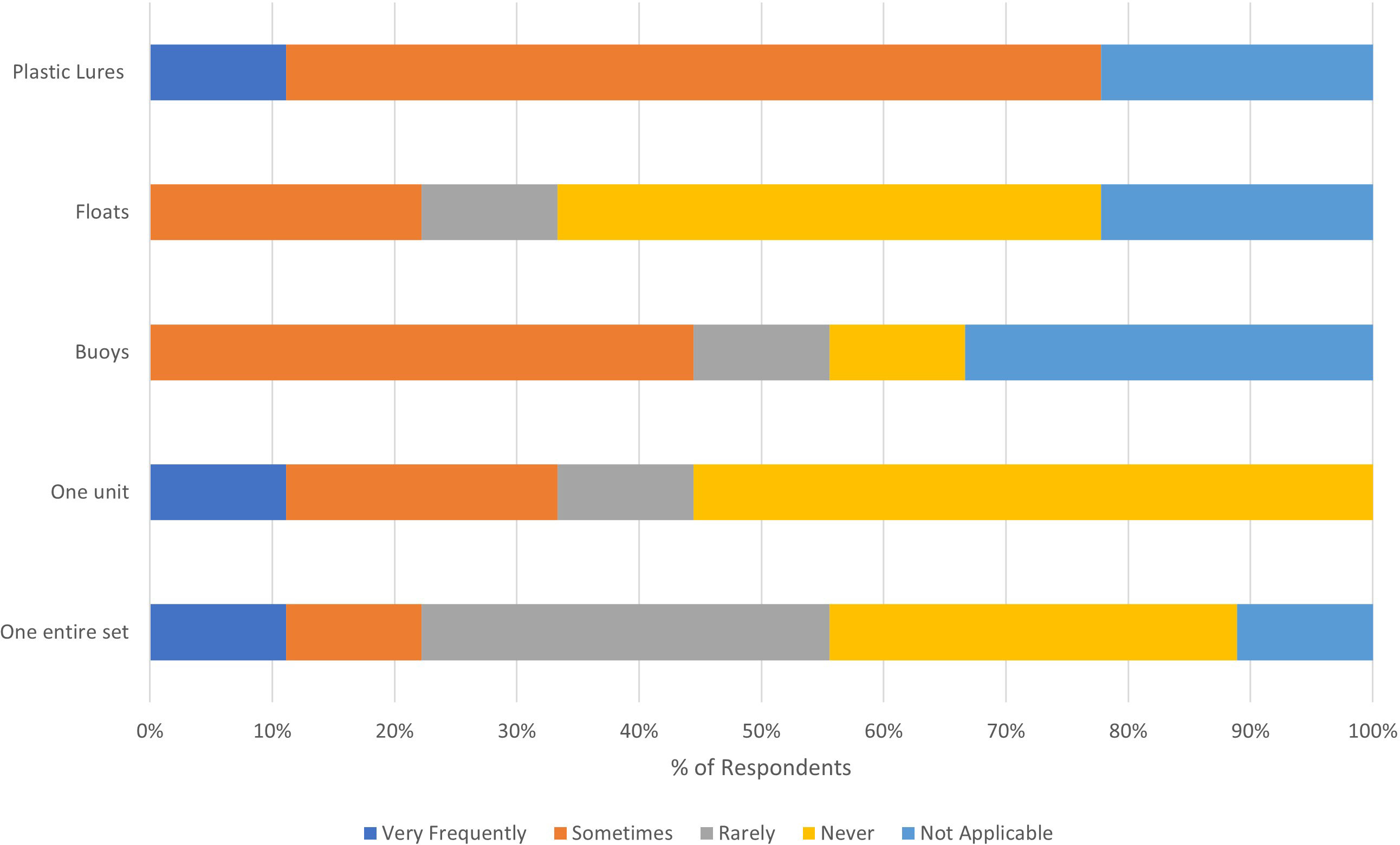
Figure 6 Summary of interview results from Antigua and Barbuda to the question: “When or if fishing gear with hooks and lines or parts thereof are lost which of the following elements are lost and at what frequency?” (n = 9).
Encounter rates of derelict gear by divers is likely to vary depending on depth, proximity to fishing grounds and the time of year; However, they can provide valuable insight into the scale of the challenge. The results of these diver interviews have highlighted that ALDFG is not only a localised issue for Antigua and Barbuda but is also a transboundary challenge. This is underscored by the observations of divers who reported encountering ALDFG associated with Sargassum influxes as well as the observation of gear not typically utilised in the country’s fishing sector. Among the reported forms of ALDFG observed by divers were FAD components, rope, and polypropylene netting (Figure 7).
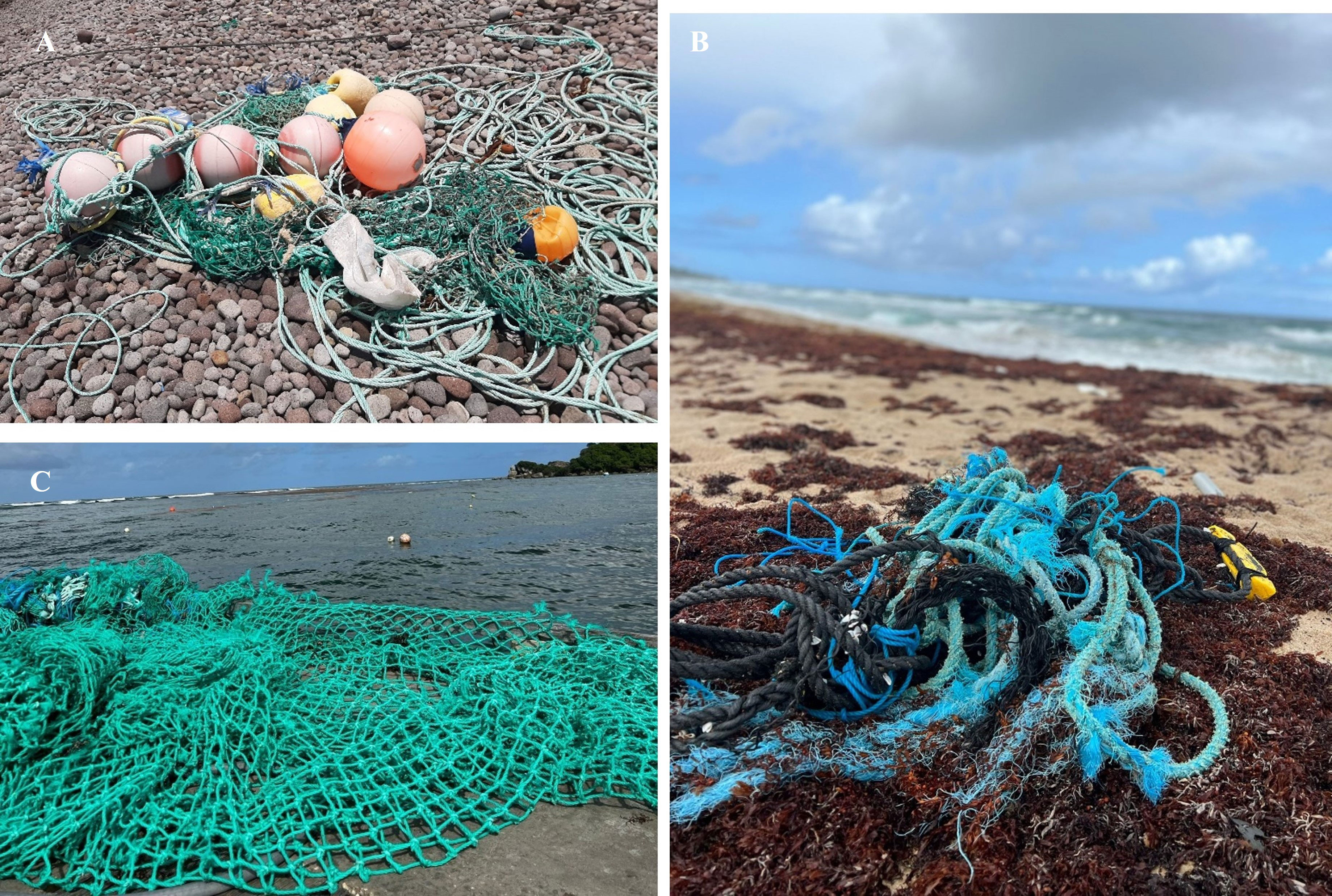
Figure 7 Examples of Gear Components that have been identified among derelict fishing gear by Divers in the Eastern Caribbean (Clockwise): (A) Recovered FAD components, (B) Tangled Rope, (C) Polypropylene Netting.
Traps were among the most frequently observed forms of derelict gear by divers along with monofilament fishing lines and ropes (Figure 8). Interestingly, multifilament/polypropylene net fragments were also identified as a major form of encountered ALDFG as noted by 89% of the divers interviewed. These nets are not typically utilised by small-scale fishers in Antigua and Barbuda and have likely drifted into coastal areas from outside the country’s EEZ or may be cut away from MFADs. Additionally, 56% of divers reported encountering FAD components (mainly buoys, ropes or FAD heads). These, often, had markings in French, indicating that they either drifted from neighbouring French territories or were illegally set in Antigua and Barbuda’s EEZ by French fishers. Other components of gear identified by divers included octopus traps and fish crates that may have drifted across the Atlantic (based on the markings observed), crab traps and spearfishing equipment.
For the two most frequently reported ALDFG gear types (traps and polypropylene/multi-filament net fragments) the frequency with which such gear was encountered was also assessed (Figure 9). More than half of the respondents (62%) reported encountering traps frequently, while 25% noted that they observed traps only sometimes. In contrast only about one third (1/3) of the respondents reported encountering the polypropylene nets frequently, and 45% observed them sometimes (Figure 8). Divers who encountered these large nets reported that they generally returned them to shore and utilised them to construct conch baskets and fencing among other uses. Many of the divers who were interviewed noted that monofilament fishing lines were mainly found in shallow areas, snagged on reefs and rocks. One interviewee reported on having removed 15 lbs of monofilament line from a shallow reef system located within the National Park during a coastal clean-up. Based on the location and the manner in which the lines were found the diver, who is also an expert marine ecologist, surmised that the lines were likely due to shore-based, recreational fishers and not commercial fishers. Shore-based fisheries are not regulated in Antigua and Barbuda.
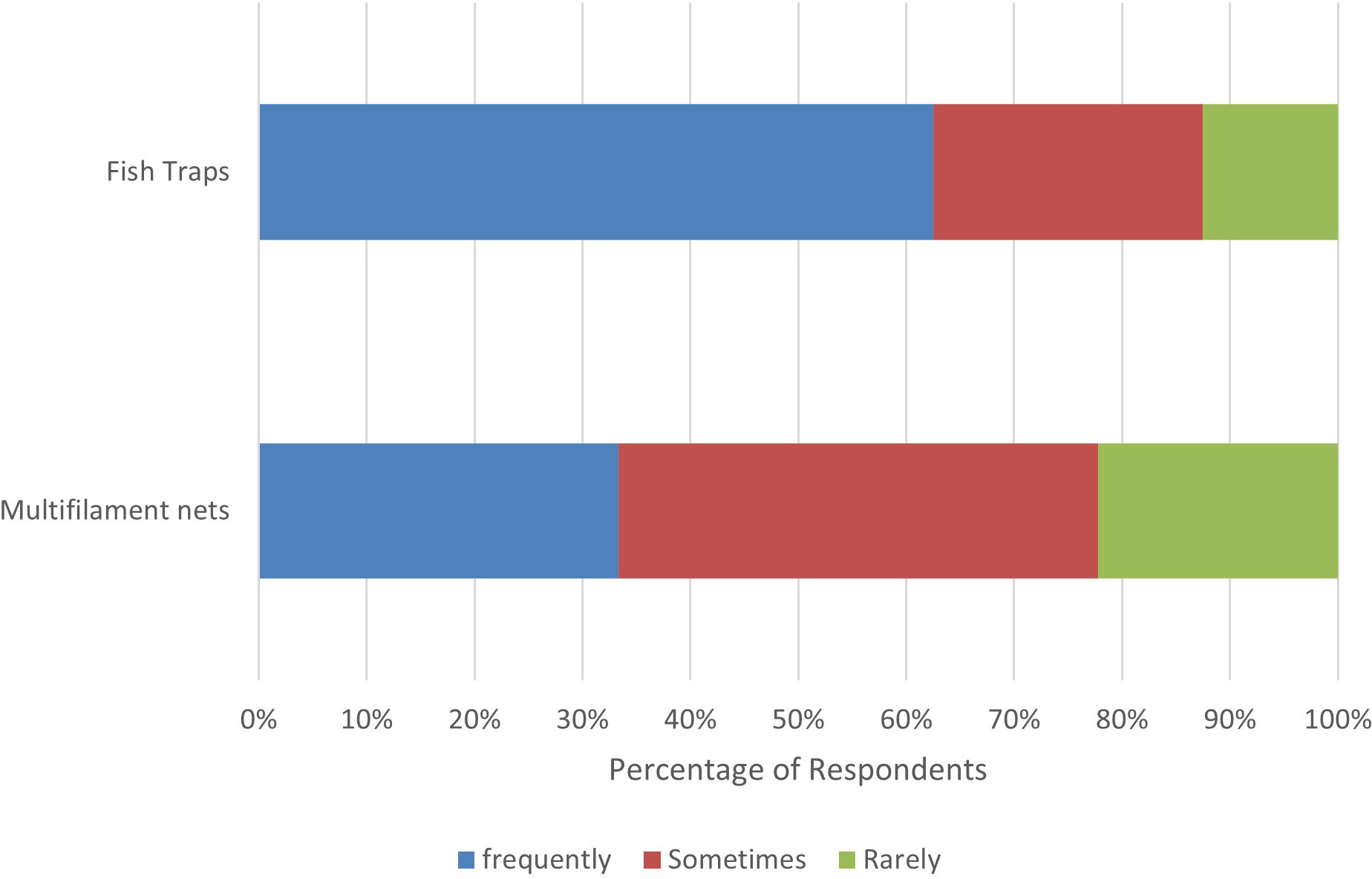
Figure 9 Encounter rates of derelict traps and multi-filament/polypropylene nets by divers in Antigua and Barbuda (n = 9).
3.2.2 Dominica
As in Antigua and Barbuda, the scale of fishing gear loss in Dominica may be influenced by a number of factors. In contrast to Antigua and Barbuda, more than 60% of those interviewed indicated that they sometimes experienced the loss of marker buoys (Figure 10). This result is not surprising given that fishers in Antigua and Barbuda typically set traps underwater without buoys, while Dominica fishers continue to mark traps with surface markers many of which are fabricated from plastic bottles. More than half of fishers indicated that they experienced the loss of a single unit of traps either frequently or sometimes while this number was much lower when fishers were asked if they experienced the loss of an entire set of traps (>70% as compared just under 30%).
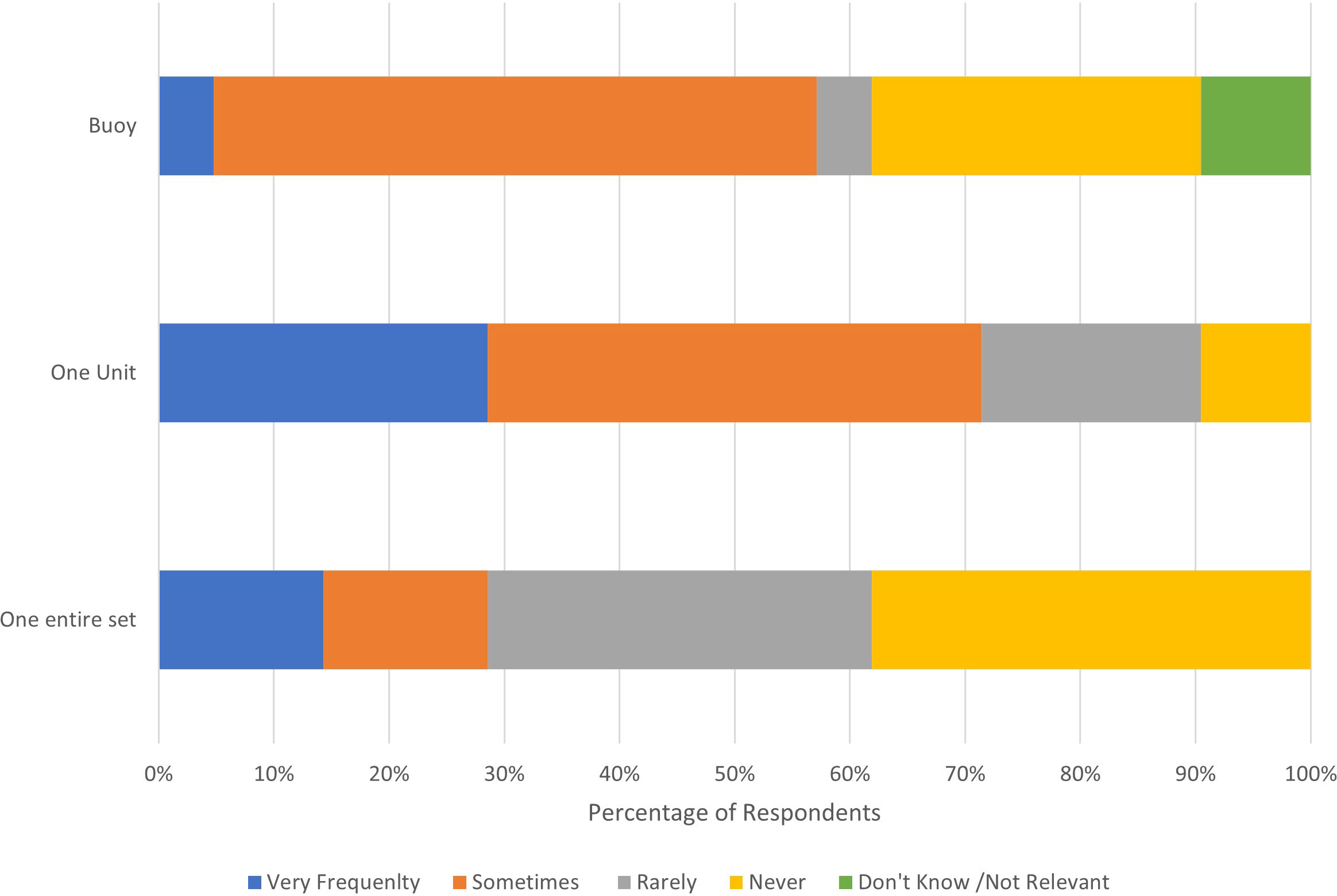
Figure 10 Summary of interview results from Dominica to the question: “When or if fish traps or parts of traps are lost which of the following elements are lost and in what frequency?”. (n = 21).
The rate of loss for fish traps was highly variable among interview participants ranging from 1 to 50 traps lost per year, at an average loss rate of 17 traps per fisher, per year in Dominica. While this number seems quite similar to the average experienced in Antigua and Barbuda, it should be noted that trap fishers in Dominica reported fishing between 3 and 60 traps per trip at an average rate of 16 traps per fisher per trip. Based on the most recently available census data for the Dominican fishing fleet, there were 151 trap fishers in 2011. Thus, based on the reported averages, it can be estimated that fishers lose approximately 2, 567 traps per year on that island. This is rate of loss is concerning, especially when compared to the estimated 2, 416 traps deployed across the fishing fleet during regular operations.
Few line fishers (21% of respondents) indicated that they experienced the loss of a complete set of lines either frequently or sometimes, while almost all interview participants (~89% of respondents) admitted to having lost at least a single line unit (Figure 11). As in the case of Antigua and Barbuda more than half (~84%) of those interviewed in Dominica admitted to having lost artificial lures either frequently or sometimes. The loss of buoys alone was rarely experienced as most fishers indicated that once the buoys were lost it was likely that the entire unit of line would also be lost
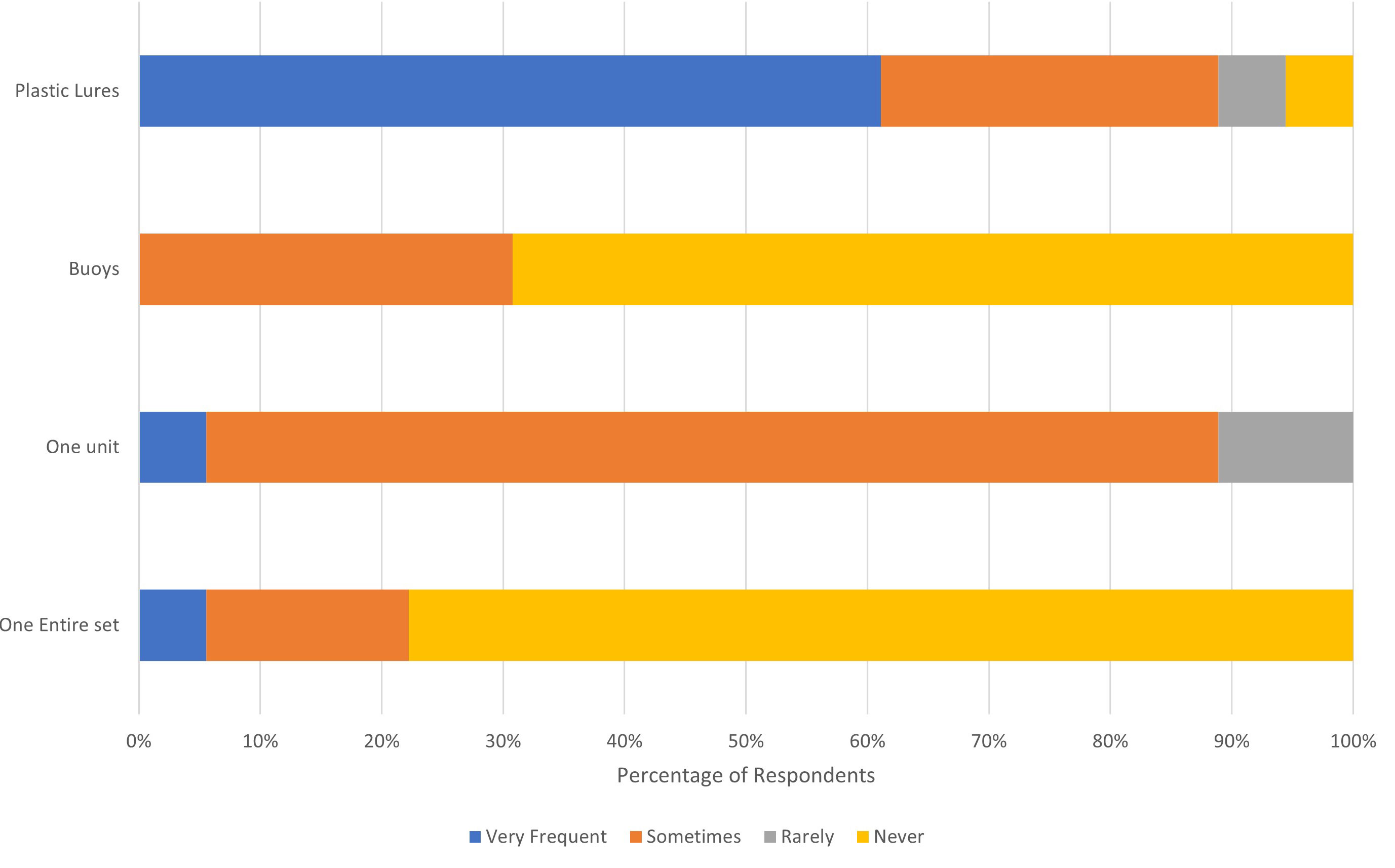
Figure 11 Summary of interview results from Dominica to the question: “When or if fishing gear with hooks and lines or parts thereof are lost which of the following elements are lost and at what frequency?”. (n=18).
Unfortunately, only five divers could be interviewed in Dominica. Of the various forms of derelict gear encountered by divers, fish traps followed by monofilament lines were the most frequently observed by interviewees (Figure 12). Although much of Dominica’s line fishery targets large pelagics in the deep ocean, interviewees reported observing monofilament lines in relatively shallow areas. One interviewee suggested that this was the result of nearshore/shore-based fishing. Three divers reported occasionally seeing the large polypropylene nets. When encountered, these nets were either left at sea, as they are known to attract fish when floating or returned to shore to make hammocks and other upcycled products.
When considering the frequency with which the most commonly observed gears were encountered, 80% of interviewed divers indicated that they saw derelict traps either rarely or sometimes, although one person indicated that they saw derelict traps all the time (Figure 13). Contrastingly, all interviewees indicated that they encountered derelict monofilament line fragments either, always, frequently or rarely (Figure 13). This result is perhaps not surprising given that Dominica’s fishing sector is largely based on the harvest of pelagic resources, despite many of the fishers who participated in this research utilising multiple gear including traps for the harvest of demersal species.
3.3 Understanding the impacts of ALDFG in the Eastern Caribbean
The academic literature is rife with numerous articles that have presented significant information on the range of socioeconomic, ecological, and other impacts associated with ALDFG. The purpose of this section is not to restate what has already been presented by numerous academics but to consider the examples and cases highlighted by divers and fishers who formed part of this research, as well as to present preliminary estimates of the ghost fishing potential of lost traps and associated socioeconomic impacts.
In addition to indicating the frequency of encounters with various forms of ALDFG, divers were asked to comment on whether the gear was impacting any marine life or habitat. Derelict traps in both Antigua and Barbuda were often found with fish and/or crustaceans entrapped in them. Several divers, however, indicated that older traps lost their catching function as they became degraded over time or were damaged by either sharks or eels trying to prey on entrapped marine life. One diver shared his observation that traps that broke down resulted in a scarring of the benthic environment.
Ghost fishing associated with derelict traps have been documented in a number of fisheries both within (Renchen et al., 2008; Norris et al., 2011; Renchen et al., 2014) and outside the Caribbean region (Erzini et al., 2008). Do and Armstrong (2023) estimated the average annual catch rate for ghost traps to be 2.77 organisms per trap. While this number seems relatively low it is consistent with a number other studies which also observed relatively low mortalities associated with derelict traps and decreasing efficiency as traps degrade (Renchen et al., 2014; Goodman et al., 2021). This estimate, however should be considered in the context of fish stock health as well as the total amount of derelict traps within the fishery. For instance, given estimates of annual trap losses in Antigua and Barbuda, and Dominica, the study by Do and Armstrong (2023) suggests that ghost traps may be responsible for the capture of approximately 6, 296 and 7, 110 marine organisms each year, respectively. Norris et al. (2011) estimated a total of four fish would equate to a pound, which is the unit used for fish sales in both countries. By this metric, derelict traps in Antigua and Barbuda may be responsible for the capture of an estimated 1 574 pounds of fish annually, while in Dominica this would equate to an estimated 1 777.5 pounds. This is valued at $15, 740 East Caribbean dollars in the case of Antigua and Barbuda and $14, 220.00 East Caribbean dollars in the case of Dominica, based on the market price of $10/pound and $8/pound respectively, as reported by fishers. This assumes that all fish captured within the traps are of commercial value but does not take account for lobsters which capture a higher price on the market.
As reported by the divers, both gillnets and large polypropylene nets were observed to have marine life entangled in them; however, divers who encountered the polypropylene nets indicated that entanglement of marine organisms was relatively rare. Morey eels, turtles and lobsters were among the marine life observed entangled in derelict nets. Derelict gill nets were also observed entangling coral reefs while one diver indicated they had observed a reef being smothered by a large section of the polypropylene net. Fishers in both Antigua and Barbuda, and Dominica noted that, when found floating, polypropylene nets often acted as drifting FADs so that fishers often target these areas for the capture of pelagic resources. In Antigua, one diver reported that a large gill net had created a navigational hazard as the net, which had likely been abandoned by the fisher, had become entangled in rocks and stretched over 400 metres. The diver reported taking several days to remove the net, sections at a time.
Fishing line was most often encountered snagged around reefs; However, one conch diver reported seeing a nylon fishing line wrapped around the horns of a queen conch. Divers who reported encountering ropes mainly observed these encrusted on reefs. However, one individual reported seeing a turtle entangled by a large mass of rope mixed with net. Because the FAD parts that were encountered were usually just the buoys none of the divers reported seeing them impacting wildlife. However, the possibility remains that large masses of buoys may become navigational hazards.
4 Discussion
Fish trap losses in both Antigua and Barbuda, and Dominica appear to be a major challenge and contributor to ALDFG. In both cases severe weather has emerged as the leading driver of trap loss, as reported by more than 90% of respondents. These results are consistent with the findings of other similar studies where severe weather was found to be the most significant driver of fishing gear loss in Sri Lanka (Gallagher et al., 2023) and the second most cited cause of trap loss, globally (Richardson et al., 2021a). Richardson et al. (2021a) also noted that snagging on benthic obstructions was a major driver of loss for gear that came in contact with the seafloor. While that assessment did not include snagging among the list of drivers for the trap assessment, 70% of those interviewed cited avoidance of snagging areas as a major preventative action (Richardson et al., 2021a). In both Antigua and Barbuda, and Dominica snagging of benthic obstructions was cited by more than 70% of respondents as a cause of trap loss.
This study has revealed that critical differences in how trap fishers operate across the study area, have likely led to differences in some of the other major associated drivers. For instance, many trap fishers in Antigua and Barbuda have switched to setting traps underwater in order to avoid theft. However, this appears to have led to increasing gear conflicts on overcrowded fishing grounds as traps become entangled with each other. The reluctance of fishers to utilise marker buoys has been shown to lead fish trap loss in other regions (Vadziutsina and Riera, 2020). Fishers in Dominica, on the other hand, continue to set traps on buoys. Unfortunately, in many instances, fishers do not utilise proper buoys, opting instead to use Clorox or water bottles to mark the location of their traps. This has created a twofold problem for fishers in Dominica. The first is the high incidences of traps being cut by vessel traffic, while the second is the increased likelihood that buoys may become submerged if the bottles take on water. Concerns about the use and poor visibility of “homemade” marker buoys for fish traps have also been raised in the neighbouring island of Montserrat where they have become a navigational hazard to commercial vessels traversing shipping grounds (Dosell et al., 2021).
More than 80% of fishers in Dominica cited drifting of gear out of range as a frequent cause of trap loss, often leading to such gear going “over the edge” into deeper waters. The use of area-based management measures to separate fishing operations from areas of high vessel traffic as well as the use of purpose-fit buoys with higher visibility as advised in Gilman et al. (2022) could help to curb trap losses in Dominica’s trap fishery. In Antigua and Barbuda, on the other hand there is a strong need for improved fisher communication in order to reduce gear conflict. Additionally, to mitigate the impacts of lost traps promoting the use of biodegradable panels in both cases should be prioritized.
Comparing the results from the current assessment with recent predictive modelling assessments of ALDFG in Montserrat and Belize (Antonelis and Drinkwin, 2021; Antonelis et al., 2022) reveals a number of similarities. Severe weather has been revealed to be among the top two major causes of trap loss in all four states, while strong currents is also among the top four drivers (Table 1). As the Caribbean region continues to experience more frequent and severe storms it will be critical for fisheries managers and fishers to enact strategies to reduce the number of traps lost due to severe weather.
The snagging of shallow reefs by fishing line in Antigua and Barbuda is another area of concern, particularly since this appears to be due to the recreational, shore-based fishery which is not regulated. An area-based management approach could help to mitigate this issue (Gilman et al., 2022). For example, fisheries authorities could move to prevent shore-based fishing in areas with a high probability of snagging or areas with sensitive habitats. However, because recreational fishers do not require a permit to fish from shore, this would need to be accompanied by a very strong public outreach programme to increase the likelihood of compliance.
The relatively high number of fishers who attributed both line and trap loss to faulty gear is concerning. Richardson et al. (2021a) observed that gear maintenance was an important factor not only with regard to the lifetime of the gear but also impacted loss. Thus, to reduce losses resulting from faulty gear it is recommended that fishers undertake routine examination and maintenance of gear before any fishing trip.
While fisheries interventions may aid in curbing ALDFG resulting from local drivers, external drivers such as weather, sargassum and the transboundary movement of derelict gear may be harder to manage. For instance, the incidences of MFAD components drifting into these islands from neighbouring French territories cannot be addressed without the cooperation of fisheries and other authorities in those islands.
The loss of locally deployed MFADs may be reduced through a combination of fisheries and non-fisheries control measures. For instance, area-based management may aid in the reduction of losses resulting for vessel traffic, by ensuring MFADs are deployed away from shipping lanes and other navigation zones. This would require the cooperation and collaboration of fisheries and port management authorities, while hydrographic agencies and/or charting authorities should be engaged to ensure their locations are precisely charted and communicated to mariners. Ensuring MFADs are compliant with gear marking regimes and adequately fitted with lights and radar reflectors is also critical to reducing losses. Frequent inspection of MFAD mooring lines and the use of durable materials for surface and subsurface components (anchors, lines and surface buoys) could also aid in this regard (Gilman et al., 2022). In recent years the use of submerged/subsurface MFADs has been promoted, as they have been shown to reduce vandalism, may be used in high traffic areas and can reduce wear on FAD lines associated with waves and storms (Taquet, 2013).
This study has demonstrated that the dive community has played and can continue to play a crucial role in managing ALDFG in these small islands, particularly for derelict gear that may be submerged and transboundary. As was shown through this research, divers routinely encounter various forms of ALDFG while diving and several have indicated that they actively seek to remove small ALDFG fragments such as lines or nets from reef areas. However, with no incentive or mechanisms to report these encounters a major opportunity is lost to elicit their support in managing this threat. Fisheries officials could consider instituting a no-fault online reporting system to encourage recreational divers to report encounters with ALDFG.
As has been previously highlighted the small-scale fisheries of the Eastern Caribbean are diverse and complex. This diversity is borne out not only by the multi-gear, multi-species nature of the fisheries but also by environmental heterogeneity and variabilities in the local drivers of loss. Mitigating the impacts of ALDFG requires that management approaches match local circumstances (Gilman et al., 2022). Therefore, it is important to continue uncovering the diversity of issues and challenges relevant to the management of this threat within the context of Eastern Caribbean small-scale fisheries.
5 Conclusion
The loss of fishing gear, particularly for small-scale fisheries in a region prone to tropical cyclones and seasonal swells, is difficult to curb completely. This notwithstanding, the results of these fisher surveys have provided valuable insight into those drivers that could be managed with the right fisheries interventions. This study is seen as only a first step in understanding the drivers, scale and impact of ALDFG the Eastern Caribbean sub-region. While inferences can be made based on the results of this study, it is important to acknowledge the variabilities that may exist across the sub-region and which are inherent to small-scale fisheries, globally. As has been shown by this study, cultural differences and local customs as well as the biogeography of the coastal environment may play critical roles in shaping the fisheries as well as impacting when and how fishing gear become derelict. The current study, despite its limitations, does provide a critical baseline for the two islands that formed part of the assessment. They also present an opportunity for comparisons with similar studies both inside and outside the Eastern Caribbean sub-region. It is hoped that this assessment will meaningfully contribute to the growing body of literature on ALDFG, while helping to fill knowledge gaps as they relate to ALDFG associated with small-scale fisheries. ALDFG in Eastern Caribbean small-scale fisheries is a real threat that is already resulting in impacts to fishers, marine organisms and marine benthic communities. Therefore, it is critical that work continues in seeking to elucidate on the overall scale of the problem for the sub-region.
Data availability statement
The raw data supporting the conclusions of this article will be made available by the authors, without undue reservation.
Ethics statement
The studies involving human participants were reviewed and approved by World Maritime University Research Ethics Committee. The patients/participants provided their written informed consent to participate in this study or recorded their verbal consent at the start of the interview.
Author contributions
Conceptualisation of this research, methodology, data collection, data analysis and interpretation, all assessments, writing and editing of the manuscript was completed by the sole author of this research. The work was supervised by Dr. Aspasia Pastra, Dr. Ronan Long and Dr. Meinhard Doelle before his passing. All authors contributed to the article and approved the submitted version.
Funding
This work has been funded by the Nippon Foundation, which funds the Closing the Circle Programme-Marine Debris, Sargassum and Marine Spatial Planning in the Eastern Caribbean, at the World Maritime University (WMU)-Sasakawa Global Ocean Institute.
Acknowledgments
This paper is dedicated to the late Dr. Meinhard Doelle who served as my academic supervisor before his untimely passing in September of this year. The author expresses sincere gratitude to Dr. Ronan Long and Dr. Aspasia Pastra for feedback and your invaluable guidance in my ongoing research. The author would also like to acknowledge the generous funding by The Nippon Foundation of the World Maritime University (WMU) - Sasakawa Global Ocean Institute as well as for The Nippon Foundation & WMU-Sasakawa Global Ocean Institute's ‘Closing the Circle Programme: Marine Debris, Sargassum and Marine Spatial Planning’ in the Eastern Caribbean. Thank you to the entire Closing the Circle team for your continued, support. My sincerest gratitude to all the fishers and divers who agreed to be interviewed as part of this research. Additionally, special thanks are extended to the staff of the Fisheries Divisions in Antigua and Barbuda, and Dominica. Thank you to Mr. Ian Horsford (Chief Fisheries Officer) and Mr. Jamie Herbert who facilitated my meeting of FAD fishers in Antigua. Thank you to Mr. Kelly Burton who assisted during my field visit to Barbuda as well as the fisheries team in Barbuda (Roy Morris, Rishma Mansign and Alexander DeSouza) who accommodated me at the office and helped to facilitate my research. Thank you to the team in Dominica who assisted in taking me around to the various landing sites, provided me with data and office facilities; Mr. Jullan Defoe (Chief Fisheries Officer), Wynonna Joseph, Zethra Baron, Kurt Hilton and Diana Degallerie. Finally special thanks are extended to my dear friend, Ms. Carlita Benjamin who offered me comfort and peace of mind when I encountered some difficulties during my field visit to Dominica.
Conflict of interest
The author declares that the research was conducted in the absence of any commercial or financial relationships that could be construed as a potential conflict of interest.
Publisher’s note
All claims expressed in this article are solely those of the authors and do not necessarily represent those of their affiliated organizations, or those of the publisher, the editors and the reviewers. Any product that may be evaluated in this article, or claim that may be made by its manufacturer, is not guaranteed or endorsed by the publisher.
Supplementary material
The Supplementary Material for this article can be found online at: https://www.frontiersin.org/articles/10.3389/fmars.2023.1139259/full#supplementary-material
References
Antonelis K., Drinkwin J. (2021) Predictive modeling of abandoned, lost, or discarded fishing gear in Belize. Available at: https://www.gcfi.org/gpml-caribe/resources/ (Accessed March 27, 2023).
Antonelis K., Drinkwin J., Shipley M., Heller C. (2022) Predictive model identifying locations of fishing gear loss or accumulation in Montserrat. Available at: https://www.gcfi.org/gpml-caribe/resources/ (Accessed March 27, 2023).
Asoh K., Yoshikawa T., Kosaki R., Marschall E. A. (2004). Damage to cauliflower coral by monofilament fishing lines in Hawaii. Conserv. Biol. 18, 1645–1650. doi: 10.1111/j.1523-1739.2004.00122.x
Clayton C. A., Walker T. R., Bezerra J. C., Adam I. (2021). Policy responses to reduce single-use plastic marine pollution in the Caribbean. Mar. pollut. Bull. 162, 111833. doi: 10.1016/j.marpolbul.2020.111833
Courtene-Jones W., Maddalene T., James M. K., Smith N. S., Youngblood K., Jambeck J. R., et al. (2021). Source, sea and sink–a holistic approach to understanding plastic pollution in the southern Caribbean. Sci. Total Environ. 797, 149098. doi: 10.1016/j.scitotenv.2021.149098
CRFM (2021). CRFM Statistics and Information Report – 2020. CRFM. Belize City, Belize. 92pp. Available at: https://crfm.int/images/documents/CRFM%20Statistics%20and%20Information%20Report%202020_Final_Published.pdf (Accessed April 17,2023).
Diez S. M., Patil P. G., Morton J., Rodrigues D. J., Vanzella A., Robin D., et al. (2019). Marine Pollution in the Caribbean : Not a Minute to Waste (English). World Bank Group. Washington, D.C. Available at: http://documents.worldbank.org/curated/en/482391554225185720/Marine-Pollution-in-the-Caribbean-Not-a-Minute-to-Waste (Accessed April 17, 2023).
Do H. L., Armstrong C. W. (2023). Ghost fishing gear and their effect on ecosystem services – identification and knowledge gaps. Mar. Policy 150, 105528. doi: 10.1016/j.marpol.2023.105528
Dosell A., Edwards D., Gregory A., Ponteen A., O’Garro J., Cornick L., et al. (2021). Using evidence from voluntary fisheries data collection programmes to support marine spatial planning and resolve multiple-use conflicts. Front. Mar. Sci. 8. doi: 10.3389/fmars.2021.635890
Erzini K., Bentes L., Coelho R., Lino P. G., Monteiro P. (2008). Catches in ghost-fishing octopus and fish traps in the northeastern Atlantic ocean (Algarve, Portugal). Fish. Bull. 106 (3), 321–327.
FAO (2020) Report of the 2019 FAO regional workshops on best practices to prevent and reduce abandoned, lost or discarded fishing gear in collaboration with the global ghost gear initiative. port Vila, Vanuatu, 27–30 may 2019. Bali, Indonesia, 8–11 June 2019. Dakar, Senegal, 14–17 October 2019. Panama city, Panama, 18–23 November 2019 (Rome). doi: 10.4060/ca9348en (Accessed October 14, 2022).
FAO (2022)Fishery and aquaculture country profiles. Dominic. In: Country profile fact sheets. fisheries and aquaculture division. Available at: https://www.fao.org/fishery/en/facp/dma?lang=en (Accessed December 30, 2022).
Gallagher A., Randall P., Sivyer D., Binetti U., Lokuge G., Munas M. (2023). Abandoned, lost or otherwise discarded fishing gear (ALDFG) in Sri Lanka – a pilot study collecting baseline data. Mar. Policy 148, 105386. doi: 10.1016/j.marpol.2022.105386
GESAMP (2021) Sea-Based sources of marine litter (London). Available at: http://www.gesamp.org/publications/sea-based-sources-of-marine-litter (Accessed September 27, 2022).
Gilman E., Humberstone J., Wilson J. R., Chassot E., Jackson A., Suuronen P. (2022). Matching fishery-specific drivers of abandoned, lost and discarded fishing gear to relevant interventions. Mar. Policy 141, 105097. doi: 10.1016/j.marpol.2022.105097
Goodman A. J., McIntyre J., Smith A., Fulton L., Walker T. R., Brown C. J. (2021). Retrieval of abandoned, lost, and discarded fishing gear in southwest Nova Scotia, Canada: preliminary environmental and economic impacts to the commercial lobster industry. Mar. Pollut. Bull. 171, 112766. doi: 10.1016/j.marpolbul.2021.112766
Hong S., Lee J., Jang Y. C., Kim Y. J., Kim H. J., Han D., et al. (2013). Impacts of marine debris on wild animals in the coastal area of Korea. Mar. pollut. Bull. 66, 117–124. doi: 10.1016/j.marpolbul.2012.10.022
Hong S., Lee J., Lim S. (2017). Navigational threats by derelict fishing gear to navy ships in the Korean seas. Mar. pollut. Bull. 119, 100–105. doi: 10.1016/j.marpolbul.2017.04.006
Horsford I. (2010) Hurricane earl-final damage assessment report for Antigua and barbuda’s fisheries sector (St. John, Antigua). Available at: https://www.islandvulnerability.org/antiguabarbuda/hurricaneearl1.pdf (Accessed October 19, 2022).
Horsford I. (2017) Hurricane IRMA-preliminary damage assessment for Antigua and barbuda’s fisheries sector f (St. John, Antigua). Available at: https://www.crfm.net/index.php?option=com_k2&view=item&id=581:hurricane-irma- (Accessed October 19, 2022).
Kanhai L. D. K., Asmath H., Gobin J. F. (2022). The status of marine debris/litter and plastic pollution in the Caribbean Large marine ecosystem (CLME): 1980–2020. Environ. Pollut. 300, 118919. doi: 10.1016/j.envpol.2022.118919
Laist D. W. (1997). Impacts of marine debris: entanglement of marine life in marine debris including a comprehensive list of species with entanglement and ingestion records. In: Coe J. M., Rogers D. B. (eds) Marine Debris. Springer Series on Environmental Management. (New York. NY: Springer) 99–139. doi: 10.1007/978-1-4613-8486-1_10
Lebreton L., Royer S. J., Peytavin A., Strietman W. J., Smeding-Zuurendonk I., Egger M. (2022). Industrialised fishing nations largely contribute to floating plastic pollution in the north pacific subtropical gyre. Sci. Rep. 12 (1), 12666. doi: 10.1038/s41598-022-16529-0
Matthews T. (2010). “Assessing opinions on abandoned, lost, or discarded fishing gear in the Caribbean,” in Proceedings of the 62nd Gulf and Caribbean Fisheries Institute, Cumana, Venezueula, November 2-6, 2009. Available at: https://www.gcfi.org/wp-content/uploads/2017/02/DerelictFishingGearReport_GCFI_2009.pdf (Accessed April 17, 2023).
Nama S., Prusty S. (2021). Ghost gear: the most dangerous marine litter endangering ocean. Food Sci. Rep. 2, 34–38. https://foodandscientificreports.com/details/ghost-gear-the-most-dangerous-marine-litter-endangering-ocean.html (Accessed April 17, 2023).
NOAA Marine Debris Program (2015). NOAA Marine Debris Program. 2015 Report on the impacts of “ghost fishing” via derelict fishing gear (Silver Spring, MD), 25. Available at: https://marinedebris.noaa.gov/impact-ghost-fishing-derelict-fishing-gear (Accessed April 17, 2023).
Norris N. J., Defoe J., Ishida M., John’ S., Barbuda A. (2011). “Ghost fishing by lost and derelict fish pots in the commonwealth of Dominica,” in Proceedings of the 63rd Gulf and Caribbean Fisheries Institute (GCF 63), San Juan, Puerto Rico, November 1-4, 2010. Available at: https://proceedings.gcfi.org/proceedings/ghost-fishing-by-lost-and-derelict-fish-pots-in-the-commonwealth-of-dominica/ (Accessed: April 17, 2023).
Pauly D., Zeller D., Palomares M. L. D. (2020)Sea Around us concepts, design and data. In: Sea Around us. Available at: searoundus.org (Accessed December 30, 2022).
Renchen G. F., Pittman S. J., Clark R. (2014). “Impact of derelict fish traps in Caribbean waters: an experimental approach,” in Bulletin of Marine. Available at: https://www.ingentaconnect.com/content/umrsmas/bullmar/2014/00000090/00000002/art00001.
Renchen G. F., Pittman S. J., Clark R., Caldow C., Olsen D. (2008) Assessing the impacts of experimental derelict fish traps in the US virgin islands ([Poster]. Proceedings of the 11th International Coral Reef Symposium. July 7 - 11. 2008. Fort Lauderdale. FL. . Available at: https://aquadocs.org/handle/1834/30680.
Richardson K., Hardesty B. D., Vince J. Z., Wilcox C. (2021a). Global causes, drivers, and prevention measures for lost fishing gear. Front. Mar. Sci. 8. doi: 10.3389/fmars.2021.690447
Richardson K., Hardesty B. D., Vince J., Wilcox C. (2022). Global estimates of fishing gear lost to the ocean each year. Sci. Adv 8, eabq0135. doi: 10.1126/sciadv.abq0135
Richardson K., Hardesty B. D., Wilcox C. (2019). Estimates of fishing gear loss rates at a global scale: a literature review and meta-analysis. Fish Fisheries 20, 1218–1231. doi: 10.1111/faf.12407
Richardson K., Wilcox C., Vince J., Hardesty B. D. (2021b). Challenges and misperceptions around global fishing gear loss estimates. Mar. Policy 129, 104522. doi: 10.1016/j.marpol.2021.104522
Singh-Renton S., McIvor I. (2015). “Review of current fisheries management performance and conservation measures in the WECAFC area,” in FAO Fisheries and Aquaculture Technical Paper No. 587, Bridgetown, Barbados: FAO, 293. Available at: https://www.fao.org/3/i4255e/i4255e.pdf (Accessed April 17, 2023).
Sinopoli M., Cillari T., Andaloro F., Berti C., Consoli P., Galgani F., et al. (2020). Are FADs a significant source of marine litter? assessment of released debris and mitigation strategy in the Mediterranean sea. J. Environ. Manage 253, 109749. doi: 10.1016/j.jenvman.2019.109749
Stelfox M., Hudgins J., Sweet M. (2016). A review of ghost gear entanglement amongst marine mammals, reptiles and elasmobranchs. Mar. pollut. Bull. 111, 6–17. doi: 10.1016/j.marpolbul.2016.06.034
Stevens B. G. (2021). The ups and downs of traps: environmental impacts, entanglement, mitigation, and the future of trap fishing for crustaceans and fish. ICES J. Mar. Sci. 78, 584–596. doi: 10.1093/icesjms/fsaa135
Taquet M. (2013). Fish aggregating devices (FADs): good or bad fishing tools? a question of scale and knowledge: FOREWORD: Tahiti international conference “tuna fisheries and FADs”, November 2011. Aquat Living Resour 26, 25–35. doi: 10.1051/alr/2013043
The Nature Conservancy (2016). The Nature Conservancy (2016). Satellite mapping of benthic habitats and bathymetry for Antigua, Dominica and saint Lucia, Caribbean. TNC. Available at https://marineplanning.wpengine.com/wp-content/uploads/2018/02/OECS-Antigua-Dominica-and-St-Lucia-Report-3Dec2016_benthic_habitat_mapping.pdf (Accessed April 17, 2023).
UNDP (2022) Future tourism: rethinking tourism and MSMES in times of COVID-19 | tourism diagnostic report-EASTERN CARIBBEAN. Available at: https://www.undp.org/barbados/publications/tourism-diagnostic-report-eastern-caribbean (Accessed March 17, 2023).
UNEP-CEP (2014). Regional action plan on marine litter management (RAPMaLi) for the wider Caribbean region. |CEP Technical Report 72. Available at: https://www.unep.org/cep/resources/report/cep-technical-report-72 (Accessed April 17, 2023).
Vadziutsina M., Riera R. (2020). Review of fish trap fisheries from tropical and subtropical reefs: main features, threats and management solutions. Fish Res. 223, 105432. doi: 10.1016/j.fishres.2019.105432
Wilcox C., Heathcote G., Goldberg J., Gunn R., Peel D., Hardesty B. D. (2015). Understanding the sources and effects of abandoned, lost, and discarded fishing gear on marine turtles in northern Australia. Conserv. Biol. 29, 198–206. doi: 10.1111/cobi.12355
Wilson M. W., Lawson J. M., Rivera-Hechem M. I., Villaseñor-Derbez J. C., Gaines S. D. (2020). Status and trends of moored fish aggregating device (MFAD) fisheries in the Caribbean and Bermuda. Mar. Policy 121. doi: 10.1016/j.marpol.2020.104148
Keywords: Eastern Caribbean small-scale fisheries, ALDFG, fishing gear loss, ALDFG drivers, ALDFG scale, ALDFG impact
Citation: Lovell TA (2023) Understanding the drivers, scale and impact of abandoned, lost and otherwise discarded fishing gear in small-scale fisheries: an Eastern Caribbean perspective. Front. Mar. Sci. 10:1139259. doi: 10.3389/fmars.2023.1139259
Received: 06 January 2023; Accepted: 05 April 2023;
Published: 25 April 2023.
Edited by:
Tomaso Fortibuoni, Istituto Superiore per la Protezione e la Ricerca Ambientale (ISPRA), ItalyReviewed by:
Giuseppe Suaria, National Research Council, ItalyAlexa Goodman, Marine Environmental Observation Prediction and Response (MEOPAR), Canada
Copyright © 2023 Lovell. This is an open-access article distributed under the terms of the Creative Commons Attribution License (CC BY). The use, distribution or reproduction in other forums is permitted, provided the original author(s) and the copyright owner(s) are credited and that the original publication in this journal is cited, in accordance with accepted academic practice. No use, distribution or reproduction is permitted which does not comply with these terms.
*Correspondence: Tricia A. Lovell, dzIwMDU1MjhAd211LnNl
 Tricia A. Lovell
Tricia A. Lovell